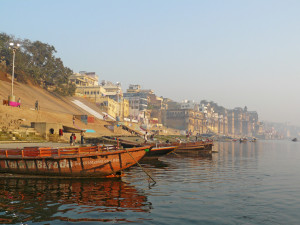Varanasi Ghats, Out of the seven holy places in India, Varanasi is amongst the oldest inhabited cities in the world that is also regarded as the most sacred pilgrimage for Hindus. Ghats of Varanasi make a unique appeal to the tourists. Popularly known as Kashi, Banaras or Ghats of Varanasi on the banks of Ganga River enchant devotees from all around the country and even abroad. The holy water of these Ghats are believed to wash all the sins and this is one reason that these Ghats are usually occupied by the priests for performing rituals, all day long.
Every day on these Ghats start with priests and devotees taking a dip in the sacred water and performing rituals all day long, The Ghats of Varanasi serve multiple purpose. While on one hand, pilgrims and tourists can offer prayers, on the other hand they serve as important commercial centers. Many people go to the ghats to relieve themselves of the strains and tensions of daily life. The Ghats are an indispensable part of Varanasi that adds to the grandeur and grace of the city.Chronicles of Varanasi
Popular Ghats of Varanasi
Dasaswamedh Ghat: According to a legend, for allowing Lord Shiva to return from a long period of banishment, Lord Brahma sacrificed ten horses at one of the Ghats in Varanasi, which is now popularly known as Dasaswamedh.
Manikarnika Ghat: Popularly known as one of the two burning Ghats, Manikarnikais the main cremation ghat. Here the deceased are consigned to flames and the family of the mortal after performing the death rituals, as guided by the priests, relieve the ashes in the holy water. From the huge stacks of wood above the Ghat, the family buys one of the many funeral packages and if people cannot afford, the body is burnt in stages. Near to this Ghat is a well, famousby the name Manikarnika Kund. It is believed to be dug by Lord Vishnu during the creation of earth.
Harishchandra Ghat: This Ghat has been named after the mythological king, Harish Chandra who once worked at the cremation ground for preserving truth and charity. It is also believed that God rewarded the king for his truthfulness and blessed him to bring back his dead son and the lost throne. Being one of the oldest cremation Ghats at Varanasi, it is also referred to as AdiManikarnika. In late 1980’s, the entire place was modernized and an electric crematorium was also introduced.
Tulsi Ghat: Named after one of the great Hindi poets of 16th century, TulsiGhat is another important Ghat, which is considered an important window as per Hindu mythology. The famous Indian epic, Ramcharitmanas was composed by the poet Tulsi Das on this sacred land.As per the legend, when the poet was writing this epic, it accidentally fell into the Ganga river, but amazingly it did not sink in the water and started floating. The house where Tulsi Das died is still preserved, adjoining the Ghat,accompanied by a temple commemorated as Lord Ram temple.
Man Mandir Ghat: Next famous name on the list is Man Mandir Ghat that was built by the King of Jaipur, Raja Savai Man Singh. An observatory furnished with ornate window casings is well-preserved near this Ghat, which is complemented by a beautiful fine stone balcony on the northern part of the Ghat. Here devotees come and pay tribute to Someshwara lingam, which is a replica of Someshwara lingam in Somanath and that is why the Ghat is originally known as Someshwara Ghat. Apart from this, Ghat is surrounded by many famous temples like Rameshwara and Sthuladanta Vinayaka.
Assi Ghat: Situated at the convergence of Asi and Ganga River, this is the southernmost Ghat where devotees take bath before paying their homage to Lord Shiva. Apart from a huge lingam under a Plaksa tree on this Ghat, there is one more lingam, known as Asisangameshwar lingam, that is, enshrined in a small marble temple. This lingam was created to honor the lord of convergence of Asi. According to the mythology, Deity Durga after assassinating the demon, Shumbh-Nishumbh threw her sword that resulted in a big stream, now referred to as Assi River. This Ghat at the Kashi Khand is also called Saimbeda Tirtha, which is believed to offer punya of all the Tirthas in one dip.
Kedar Ghat built by the Maharaja of Vijayanagar in the South is named after Shiva, who dwells in the middle of the spacious temple.This ghat is shrine popular with Bengalis and south Indians. A little below is the Gauri (Parvati) kund whose waters have healing properties
Panchganga Ghat: as its name indicates, is where five rivers are supposed to meet. Dominating the ghat is Aurangzeb’s smaller mosque, also known as the Alamgir Mosque, which he built on the site of a large Vishnu temple erected by the Maratha chieftain Beni Madhur Rao Scindia
Lalita Ghat: This Ghat is situated on the northern parts of Varanasi and is well known for its temple, Ganga Keshava. This is an entirely wooden made temple that was built in typical Kathmandu style and encompasses a manifestation of Lord Shiva.











